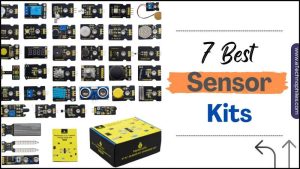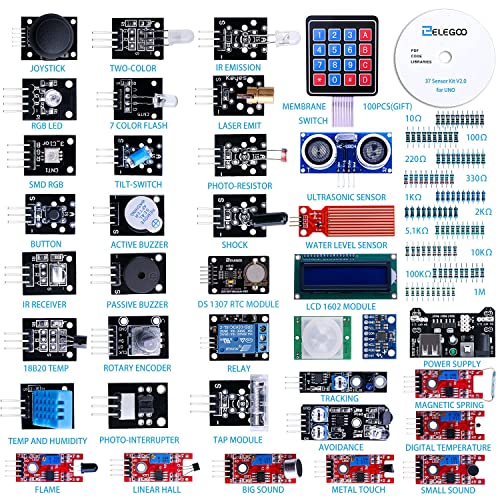Last updated on March 30th, 2024 at 11:49 am
Sensors are a vital part of any electronics project, as they are used to collect data in various forms. That’s why having the best sensor kits becomes essential to obtain this data error-free. A sensor kit contains numerous kinds of sensors and sometimes even some other electronic components to support them.
With the uncountable options available online, it is quite easy to get confused about which sensor kit to buy. We decided to help you out here by picking some of the best sensor kits in the market. We have given the complete component listing of each kit so you can decide which is the best for you. Read along to find out.
| Best Quality | Buy Now |
| Best Documentation | Buy Now |
| Value for Money | Buy Now |
| Best Overall | Buy Now |
| Kit with different variety of sensors | Buy Now |
Best Overall: ultimate STEM electronic projects starter kit
Just like the name suggests, this kit has everything you will need to get started with electronics projects. It contains more than 180 components with 50 types of varieties, that’s exactly why this is the best sensor kit on the entire list.
It contains a microcontroller board, i.e., Arduino MEGA 2560 R3, and 20 different sensor modules. Not only that but hundreds of online tutorials will make you an expert with Arduino.
Key features:
- It has a wide variety of components not found in any other kits
- 20 sensor modules for development purposes
- Guides for 33+ electronics projects
- Hundreds of online tutorials
- Includes an Arduino Mega 2560
- It also includes a power supply cable which is not provided in most kits
Best quality: GAR monster starter kit
This complete development kit is filled with sensors along with electronic components, breadboards, and controller boards. You will hardly need any extra components if you are trying to build some intermediate-level projects. You get not only 20 sensors but also 5 main development boards.
This kit has the best quality on our entire list. The kit also has several online tutorials where you can learn to carry out various projects. We really loved the huge plastic case it comes in; it gives it quite a stylish look.
Key features:
- It has 20 sensors, including the Hall Effect and Combustible Gas sensor
- Has 5 development boards viz. Uno R3, Mega 2560, Nano V3, ESP32 WiFi+Bluetooth, and ESP8266
- 16″ x 12″ durable organizer toolbox
- Free 16GB USB storage provided
- Free access to GAR Dropbox, which consists of PDFs and links to online tutorials
- Numerous code examples and detailed explanations of certain Arduino projects
- Free technical and customer support throughout the lifetime of the kit
- Lifetime replacement guarantee on all parts
Best documentation: KEYESTUDIO 37 in 1 sensor kit
This kit was designed specifically for STEM education of children and aged people alike. It has excellent tutorials for learning how different sensors can be used and operated together. Its extensive documentation provides supporting tutorials for the kit, making it the kit with the best documentation on this list.
This kit provides 37 different types of sensors that will help you in building various projects. The bright-colored cardboard box makes attractive packaging but is not that durable.
Key features:
- Super friendly kit for beginners and STEM learners
- Move from simple and graphical to the hardware and coding level of DIY electronics with this kit
- It contains 37 different types of sensors
- Online list of 37 step-by-step projects that you can carry out with this kit
- Extensive supporting knowledge about each sensor and tutorials on how to use them is provided
- Neat packaging in a cardboard box
- Each module has 3-4 pins broken out for easy plugging into a breadboard
Value for money: ELEGOO 37 in-1 sensor modules kit
This sensor kit will give you the best value for your money. It has almost all types of sensors used in common electronic circuits. Not to mention the ample supply of components that comes along. This kit is well-suited for professional lab engineers, electronics major students, and experienced hobbyists.
Even beginners can use this kit with the help of provided tutorials. Tutorials come in the form of a CD but if you don’t have the CD player then you can access the same tutorials on their website.
Key features:
- 37 types of sensors commonly used in electronic projects
- Detailed tutorials with 31 lessons that are easy to understand and easy to follow
- Schematics and wiring diagrams with colorful illustrations present in the tutorials
- A CD full of IDE for programming codes is provided with the kit. The same data is also available on the provided website.
- Codes are editable so that you can customize them as per your needs.
- Neat, sturdy plastic toolbox packaging with compartments for each type of component
Kit with different variety of sensors: KEYESTUDIO 48 Sensors Modules Starter Kit
This kit has the most number as well as a variety of sensors on our entire list. It is well-designed to include even non-traditional (not commonly used) sensors.
If you are an engineering student, then this kit will serve as the perfect laboratory kit for your semester projects. If this kit had a controller board or two it would have made the perfect development kit.
Key features:
- This kit has sensors like the Magical Light Cup Module, TEMT6000 Ambient Light Module, etc., which are not available in any other kits on this list.
- It comes with clear instructions, labeled diagrams, and step by step guide to learn new concepts and build projects
- It makes a perfect complimentary kit to be used with other electronic kits
- It comes in a nice and sturdy cardboard box and separate plastic coverage for each component.
- Round-the-clock technical support to help you with your queries
HSU Development Kit
This electronics development kit is perfect for hobbyists and advanced learners as it contains most components used in advanced circuitry. It has more than 300 components and separate mounting plates for the Raspberry Pi, but don’t have any microcontroller board.
16 different types of sensors will keep you engaged and entertained for a while. This kit has a unique duo of micro USB power cables and an HDMI converter, which is not available in most kits in the market.
Key features:
- It contains more than 300 pieces of components
- Includes additional lengthening screws that will allow you to mount 2 Raspberry Pi models simultaneously on the mounting plate
- A color code chart for reading resistor values is provided
- Neat packaging with laptop sleeve-like bag with padding for protection
- It also has a small plastic box for storage of smaller components and wires
- Very helpful customer service to help with any queries
KEYESTUDIO Smart Home Starter Kit
A smart home kit usually contains all the sensors that are commonly used in home automation. To make it more interesting, this kit is shaped like a house with sensors placed in appropriate positions. You get to discover the wonders behind home automation, along with a little introduction to coding with this kit.
It makes a perfect gift for children interested in electronics and programming. You can operate the kit with your mobile phone and have fun learning home automation.
Key features:
- The entire kit turns out to be a house that has several sensor modules on its windows, doors, and roofs.
- The kit can detect rainfall and close the windows, turn lights on and off by detecting motion, open the door by entering the correct password, check soil humidity, keep a lookout for gas leaks, and more. It is a complete smart home.
- Control the entire system remotely via an app. It can be used on Android and iOS.
- Learn beginner-level coding with this kit
Conclusion: Best Sensor Kits
Sensors are used very commonly in electronic circuits. All electrical engineers have to deal with sensors at some point in their study. These kits serve as excellent hands-on practice tools to get acquainted with the working of different types of sensors. All these kits have something different to offer. The key features will help you decide which kit will best serve your interest.








